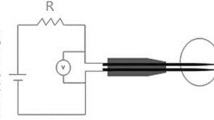Abstract
This paper is a review on implementation of measuring systems for two-phase helium, hydrogen, liquefied natural gas (LNG), and oil-formation/salty water flows. Two types of such systems are presented. The first type is based on two-phase flow-meters combining void fraction radio-frequency (RF) sensors and narrowing devices. They can be applied for superconducting accelerators cooled with two-phase helium, refueling hydrogen system for space ships and some applications in oil production industry. The second one is based on combination of a gamma-densitometer and a narrowing device. These systems can be used to monitor large two-phase LNG and oil-formation water flows. An electronics system based on a modular industrial computer is described as well. The metrological characteristics for different flow-meters are presented and the obtained results are discussed. It is also shown that the experience gained allows separationless flow-meter for three-phase oil-gas-formation water flows to be produced.
Similar content being viewed by others
References
M. Hinkelmann, FAIR-Facility for Antiproton and Ion Research. http://www.faircenter.de/fileadmin/fair/publications_FAIR/FAIR_Brochure_EN_2010.pdf.
G. V. Trubnikov et al., “Project of the Nuclotron-based Ion Collider fAcility (NICA) at JINR,” in Proceedings of the European Particle Accelerator Conference-11, Genoa, 2008, pp. 2581–2583.
H. G. Khodzhibagiyan, E. Fischer, and A. D. Kovalenko, “New design for the SIS100/300 magnet cooling,” IEEE Trans. Appl. Supercond. 16, 411–414 (2006).
Y. P. Filippov, I. D. Kakorin, and A. M. Kovrizhnykh, “New solutions to produce a cryogenic void fraction sensor of round cross section and its applications,” Cryogenics 57, 55–62 (2013).
Y. P. Filippov and K. S. Panferov, “Two-phase cryogenic flow-meters. Part II. How to realize the twophase pressure drop method,” Cryogenics 51, 640–645 (2011).
Yu. P. Filippov, “I. Flow patterns and void fraction,” Cryogenics 39, 59–68 (1999).
Y. P. Filippov and I. D. Kakorin, “A method for calibrating cryogenic void fraction RF-sensors having a round cross section and estimating their accuracy,” Cryogenics 79, 63–73 (2016).
Y. P. Filippov and V. M. Miklayev, “Choice of temperature sensors for XFEL-project,” in Proceedings of the 23rd International Cryogenic Engineering Conference ICEC’23, Wroclaw, 2010, pp. 537–542.
Yu. P. Filippov, A. M. Kovrizhnykh, V. M. Miklayev, and A. K. Sukhanova, “Metrological systems for monitoring two-phase cryogenic flows,” Cryogenics 40, 279–285 (2000).
Y. P. Filippov, S. V. Romanov, K. S. Panferov, and B. N. Sveshnikov, “Modular data acquisition system for cryogenics,” in Proceedings of the 22nd International Cryogenic Engineering Conference ICEC’22, Seoul, 2008, pp. 419–424.
Y. P. Filippov, “Cryodiagnostics of SC-accelerators with fast cycling superferric magnets,” in Proceedings of the 25th International Cryogenic Engineering Conference ICEC’25, Enschede, 2015, pp. 1129–1133.
Yu. P. Filippov, V. M. Miklayev, and A. K. Sukhanova, “Irradiation of cryogenic temperature sensors by gamma dose of 1 MGy,” Rev. Sci. Instrum. 78, 043502–1–9 (2007).
Y. P. Filippov, “How to find magneto-resistance of TVO temperature sensors in the range 0.1–10 K,” Cryogenics 50, 243–247 (2010).
Y. P. Filippov and I. D. Kakorin, “Approach to monitor large two-phase LNG flows,” Flow Meas. Instrum. 52, 163–169 (2016).
J. H. Hubbell and S. M. Seltzer, Tables of X-Ray Mass Attenuation Coefficients and Mass Energy-Absorption Coefficients from 1 keV to 20 MeV for Elements Z = 1 to 92 and 48 Additional Substances of Dosimetric Interest. http://www.nist.gov/pml/data/xraycoef/index.cfm.
Y. P. Filippov and K. S. Panferov, “Diagnostics of salty water-in-oil two-phase flow,” Int. J. Multiphase Flow 41, 36–43 (2012).
Y. P. Filippov, I. D. Kakorin, and K. S. Panferov, “Influence of temperature on diagnostics of salty water-in-oil two-phase flow,” Int. J. Multiphase Flow 58, 52–56 (2014).
I. D. Kakorin and Y. P. Filippov, “Two-phase flowmeter based on a constriction device and gamma densitometer for mixtures of oil and stratum water,” Meas. Tech. 11, 33–38 (2013).
Author information
Authors and Affiliations
Corresponding author
Additional information
The article is published in the original.
Rights and permissions
About this article
Cite this article
Filippov, Y.P., Kakorin, I.D., Kovrizhnykh, A.M. et al. Monitoring of multiphase flows for superconducting accelerators and others applications. Phys. Part. Nuclei Lett. 14, 602–614 (2017). https://doi.org/10.1134/S1547477117040082
Received:
Published:
Issue Date:
DOI: https://doi.org/10.1134/S1547477117040082




